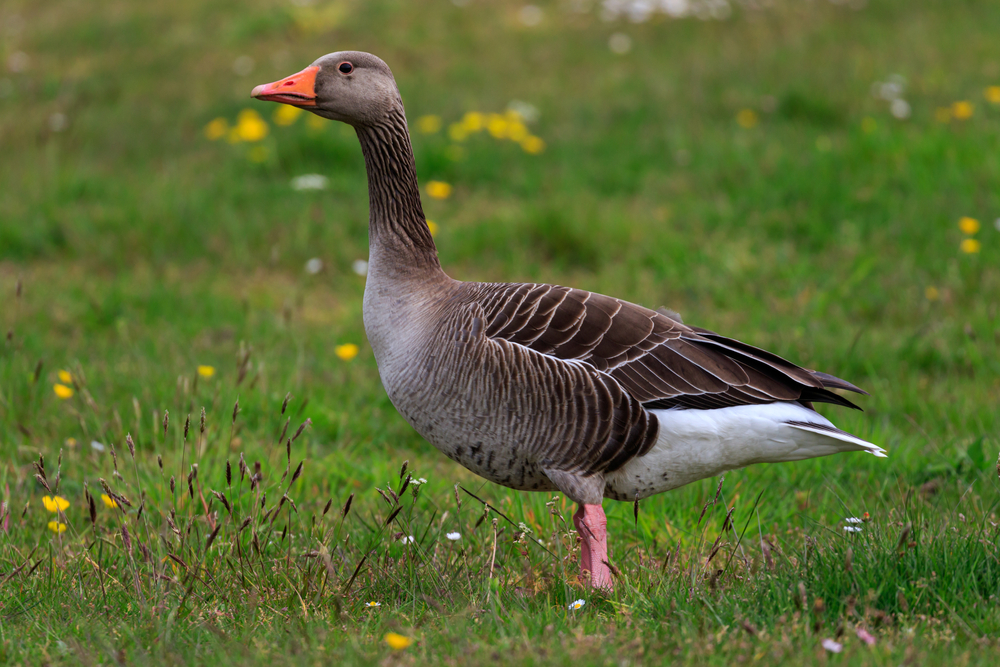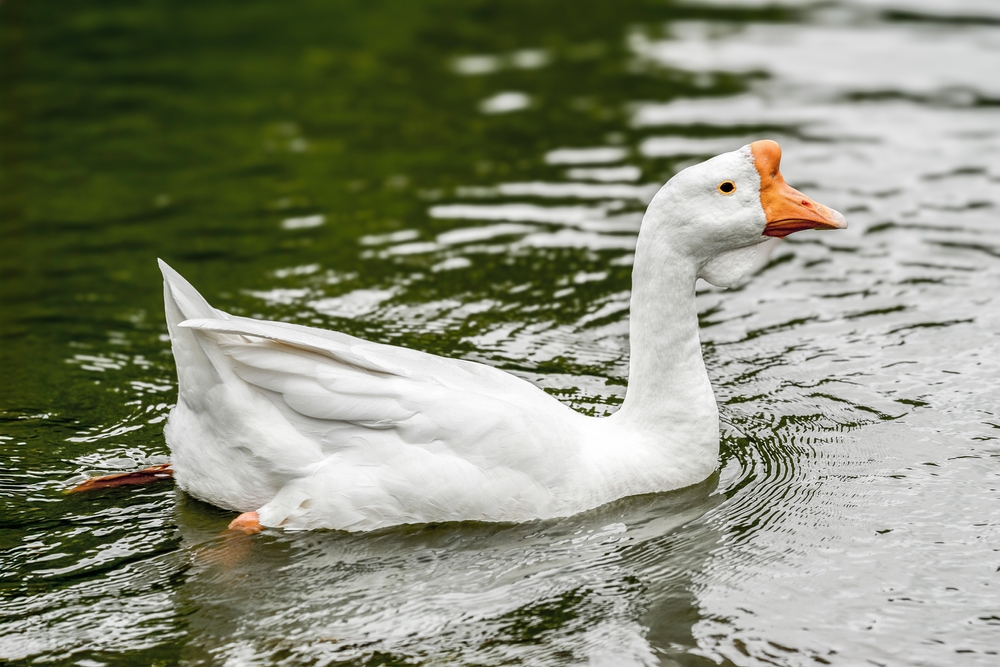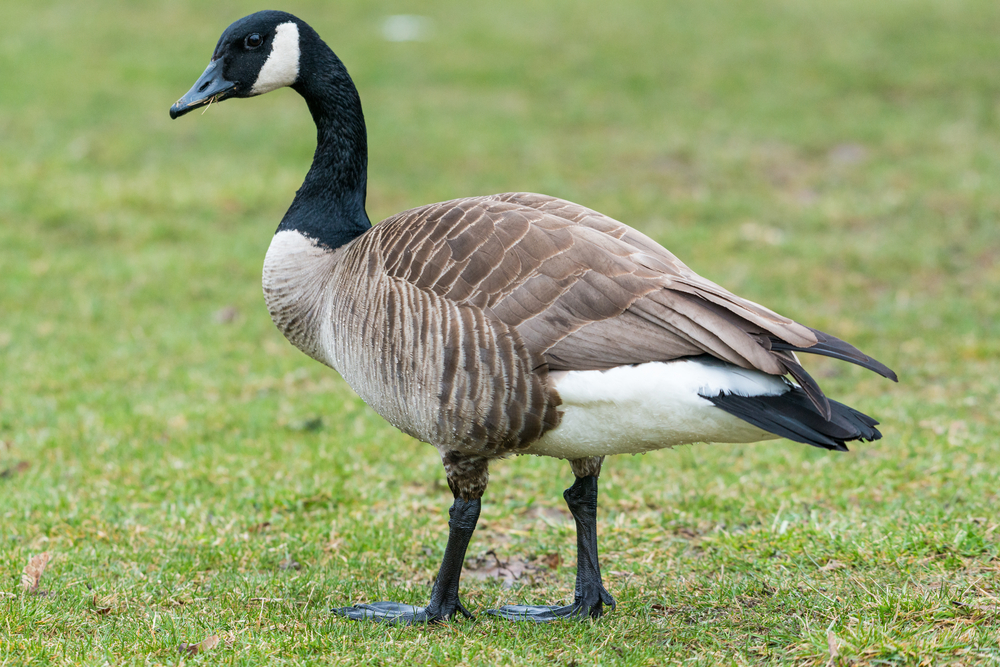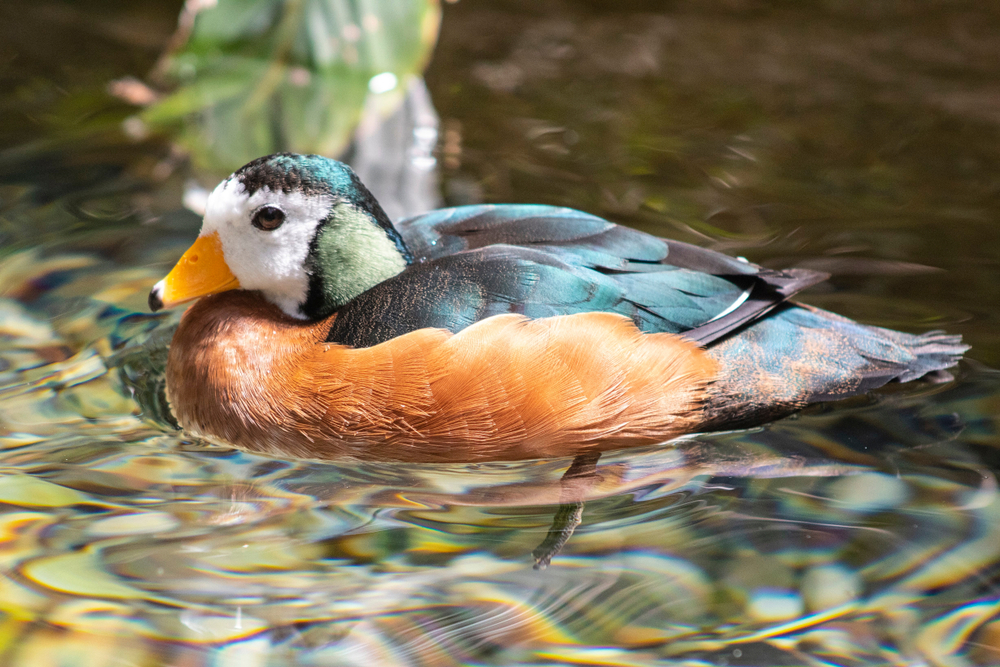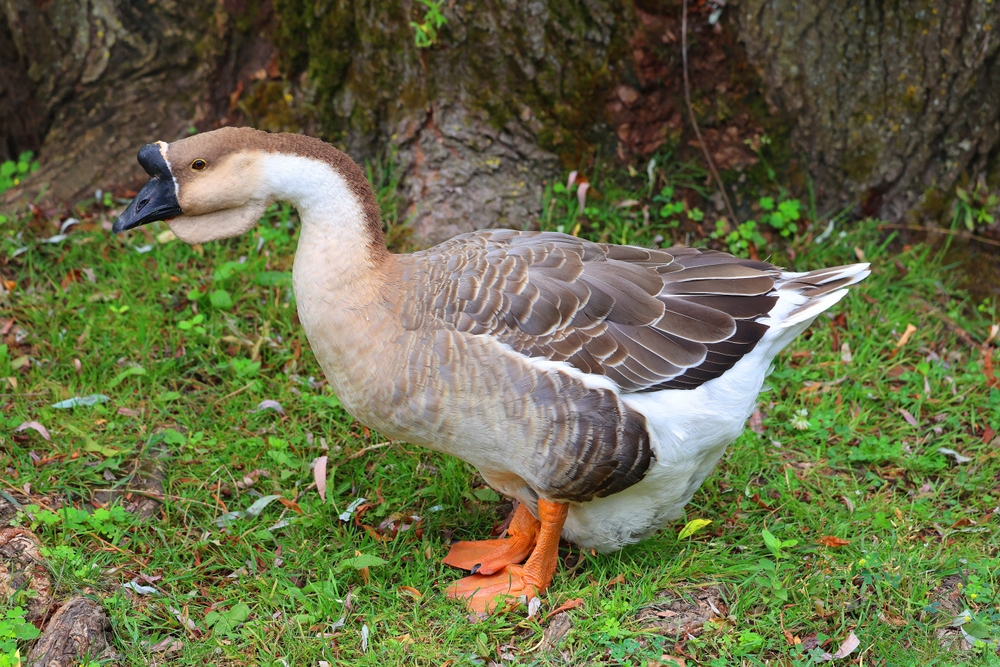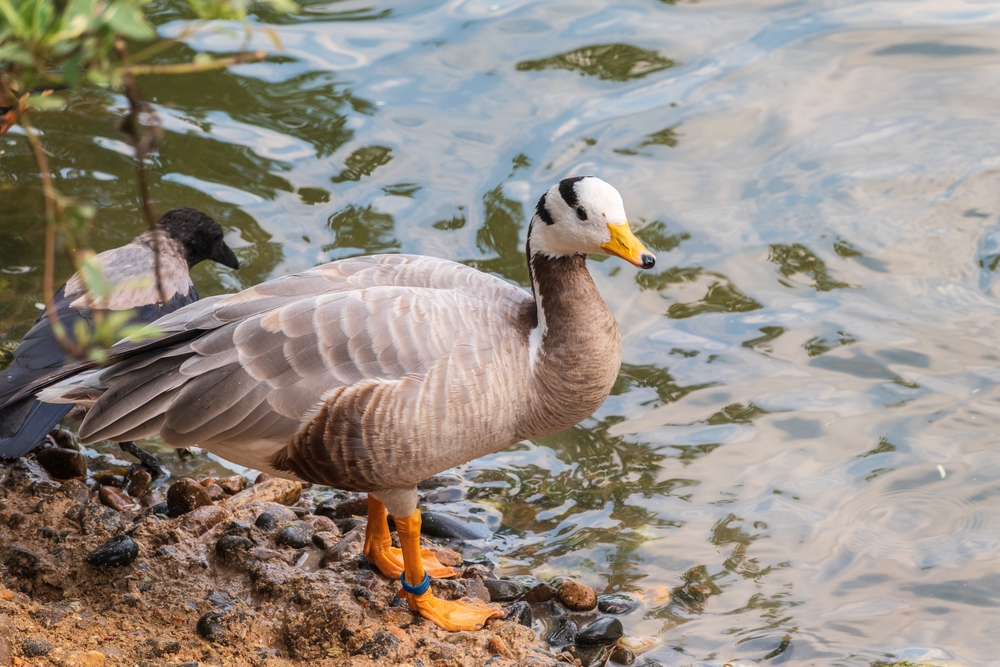The Pilgrim Goose is a domestic breed descended from the Greylag Goose (Anser anser), its closest wild relative. Like other domestic geese, it carries traits shaped by selective breeding.
About
The Pilgrim Goose (Anser anser domesticus) is a distinctive domestic goose breed in the Anatidae family, descended from the wild Greylag Goose (Anser anser). Originating in the United States in the early 20th century, this breed is notable for its unique sex-linked coloration, which allows males and females to be distinguished at hatching. It has since become a popular choice among small farmers and homesteaders for its utility, hardiness, and calm disposition.
Pilgrim Geese are medium-sized compared to heavier domestic breeds. Ganders (males) typically weigh 6 to 7 kilograms (13 to 15 pounds), while females weigh 5 to 6 kilograms (11 to 13 pounds). Their most distinguishing feature is their plumage difference by sex: males are mostly white with touches of grey, while females are primarily grey with white facial markings. This trait makes them easy to sex visually, a rare advantage among geese. Both sexes have orange bills and legs, with bright blue eyes in males and brown eyes in females.
These geese are excellent grazers, feeding on grasses, clovers, and weeds, and require minimal supplemental feed when on good pasture. They are valued for their flavorful meat and moderate egg-laying ability, producing 35 to 45 large white eggs per year.
Pilgrim Geese are known for their calm and gentle temperament, making them well-suited for small farms and families. They are attentive parents, with females showing strong brooding instincts and ganders actively guarding the flock. With proper care, they can live 15 to 20 years.
Though not as common as some heavier breeds, the Pilgrim Goose is prized for its practicality, temperament, and unique auto-sexing trait. It remains a symbol of efficient and family-friendly poultry keeping.
Physical Characteristics
The Pilgrim Goose is a medium- to large-sized domestic goose breed, instantly recognizable for its sex-linked plumage dimorphism—males and females are different colors, a rare trait among geese.
Plumage:
-
Males (Ganders): Pure white plumage, sometimes with light traces of gray.
-
Females (Geese): Gray plumage with white facial markings, lighter breast, and darker back and wings. This makes it easy to distinguish the sexes visually at any age.
Head & Beak: The head is rounded and medium in size. The bill is stout, straight, and orange, occasionally tinged with pink. Eyes are blue in ganders and brown in females.
Body & Neck: The body is broad and deep-breasted, carried slightly upright. The long neck is moderately thick and arched, allowing a proud, graceful stance. Legs and feet are orange and webbed, strong for both walking and swimming.
Size:
-
Length (Body and Tail): 28–34 in (71–86 cm)
-
Wingspan: 4.5–5.5 ft (1.4–1.7 m)
-
Tail Length: 6–7 in (15–18 cm)
Weight:
-
Adult Male (Gander): 13–14 lbs (6–6.5 kg)
-
Adult Female (Goose): 12–13 lbs (5.5–6 kg)
The Pilgrim Goose’s unique sexual dimorphism, gentle temperament, and manageable size make it both distinctive in appearance and valued as a practical domestic breed.
Reproduction
The Pilgrim Goose is well known for its reliable breeding performance and the rare advantage of sex-linked coloration, allowing the sexes to be identified at hatching.
1. Mating and Courtship:
Pilgrim Geese are generally monogamous, though in farm settings, a gander may mate with multiple females. Courtship involves head bobbing, honking, and protective posturing by the male. Their calm temperament makes them easier to manage than some more aggressive breeds.
2. Breeding Season:
Breeding begins in spring (March–May) in temperate regions, though in managed flocks, the season may extend depending on care and conditions.
3. Nesting:
The female builds a ground nest in a secluded area, using straw, grasses, and feathers plucked from her own breast. Farmers often provide nest boxes or protected corners.
4. Egg Laying and Incubation:
A typical clutch consists of 20–35 large white eggs per season, though clutches may be smaller if unmanaged. The female incubates for 28–30 days, while the male stands guard nearby.
5. Hatching and Gosling Development:
Goslings hatch covered in soft down, and their sex can be identified immediately by down coloration—males are lighter and females darker. They are precocial, walking and grazing within a day, guided closely by their mother.
6. Growth and Fledging:
Young Pilgrim Geese feather out by 8–10 weeks and become independent around 12–14 weeks. Selective breeding has emphasized steady growth and good survival rates.
7. Sexual Maturity:
Pilgrim Geese reach breeding maturity at about 2 years of age, though some females may begin laying earlier under favorable conditions.
The Pilgrim Goose’s ease of sex identification at hatching, combined with dependable brood care and productivity, makes it one of the most practical domestic goose breeds for small farms and homesteads.
Lifespan
The Pilgrim Goose is a hardy domestic breed, capable of long life when properly cared for, though longevity often depends on whether it is kept for utility, ornamental, or companion purposes.
Lifespan in the Wild (Ancestor – Greylag Goose):
Its ancestor, the Greylag Goose (Anser anser), typically lives 10–15 years in the wild, sometimes reaching up to 20 yearsunder favorable conditions.
Lifespan in Domestication:
Pilgrim Geese generally live 15–20 years on small farms and homesteads when provided with secure housing, clean water, and a balanced diet. Under excellent care, some individuals may live up to 25 years or more.
Threats to the Pilgrim Goose:
-
Predation: Vulnerable to foxes, raccoons, coyotes, and stray dogs if not securely housed.
-
Health Issues: Risk of obesity, foot problems, and reproductive strain in heavy layers can reduce life expectancy.
-
Environment: Poor shelter, inadequate grazing, or limited water access can shorten lifespan.
-
Human Use: Many Pilgrim Geese raised for meat are harvested at a young age, long before reaching their natural lifespan.
Conservation and Care:
As a heritage breed, Pilgrim Geese thrive best with attentive management. Secure enclosures, proper feed, access to grazing areas, and routine health checks help maximize their lifespan and wellbeing.
Eating Habits
The Pilgrim Goose is an efficient grazer and browser, with feeding habits that make it both self-sufficient and practical for small farms and homesteads.
Diet:
They feed primarily on grasses, clover, weeds, and aquatic plants. Farmers often supplement with grains, cracked corn, barley, oats, and commercial waterfowl feed. Fresh vegetables, such as lettuce, spinach, and cabbage, are also enjoyed.
Foraging Strategy:
Pilgrim Geese are dedicated pasture grazers, spending much of their day cropping grass and maintaining fields. Their broad, sturdy bills are well-adapted for shearing vegetation efficiently.
Feeding Behavior:
They are social feeders, grazing side by side in flocks. They require constant access to clean water, not only for drinking but also for bill cleaning while eating.
Human Feeding Practices:
On farms, they are usually provided with supplemental grain during winter or when pasture quality is poor. Overfeeding rich grains can lead to obesity, which is common in heavier domestic goose breeds if not managed.
Seasonal Feeding:
-
Spring and Summer: Fresh grasses, weeds, and natural forage form most of the diet.
-
Autumn and Winter: Grains, hay, and root vegetables are provided when natural grazing is limited.
Ecological and Practical Role:
Pilgrim Geese are often used as “living lawnmowers” or weed control birds in orchards, vineyards, and pastures, reducing the need for herbicides and mechanical mowing.
The Pilgrim Goose’s strong grazing instincts, adaptability to both free-range and managed feeding, and usefulness in land management make it a highly valued domestic breed.
Uniqueness
The Pilgrim Goose is one of the most unusual and practical domestic goose breeds, standing out for both its appearance and utility:
Sex-Linked Dimorphism: The Pilgrim Goose is among the very few goose breeds where males and females can be distinguished by color at hatching—ganders are white, while females are gray with white facial markings. This makes sexing effortless for farmers and breeders.
Gentle Temperament: Unlike many domestic geese, Pilgrim Geese are known for being calm, docile, and easy to handle, making them popular with small-scale farmers and families.
Medium Size with Utility: They are smaller and lighter than heavy meat breeds like the Toulouse or Embden Goose, but still provide good meat and egg production, making them versatile.
Excellent Grazers: Pilgrim Geese are highly efficient grazers, often employed as natural weed control in gardens, orchards, and vineyards.
Heritage Status: They are considered a heritage breed, meaning they have been maintained for generations with relatively little change, preserving traditional domestic traits.
Endangered Recognition: In the U.S., the Pilgrim Goose is listed as a threatened heritage breed by the Livestock Conservancy, valued for its rarity and importance in agricultural history.
Distinctive Appearance: The combination of white ganders and gray females creates a visually striking flock, unlike any other goose breed.
The Pilgrim Goose’s rare sex-linked coloration, calm temperament, and multipurpose usefulness make it one of the most distinctive and practical domestic goose breeds in the world.
Be the First to Share Photos of This Species.
FAQ’s
1. What is the closest species to the Pilgrim Goose?
2. How does the Pilgrim Goose compare to other geese?
It is smaller and lighter than heavy breeds like the Toulouse or Embden Goose, but larger than ornamental breeds. Its unique sex-linked plumage dimorphism sets it apart—males are white, females are gray. Pilgrim Geese are also more docile and family-friendly compared to more aggressive breeds.
3. What farms or settings provide the best opportunities to see a Pilgrim Goose?
What farms or settings provide the best opportunities to see a Pilgrim Goose?
-
Small family farms and homesteads, where they are valued for calm temperament and utility.
-
Heritage breed farms, especially in North America, where conservation breeding programs maintain them.
-
Backyard flocks, where their ease of sexing and gentle nature make them popular with hobby keepers.
-
Agricultural fairs and poultry shows, where Pilgrim Geese are exhibited as a rare and distinctive domestic breed.




































































